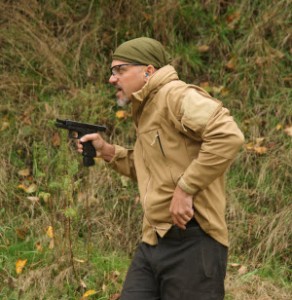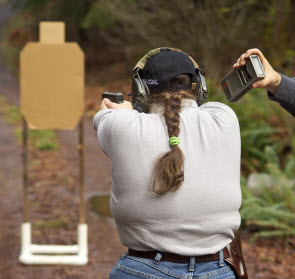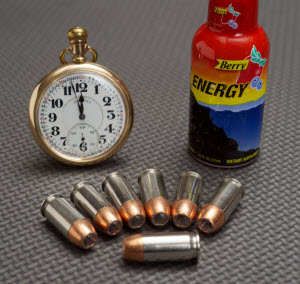The mantra is that the person who shoots the fastest or gets his gun back into operation first after running out of ammo will come out on top. “There is no second-place winner” the saying goes, and the only way to figure out who comes in first is to measure. The only thing you can measure, of course, is time!
This isn’t surprising given the influence that competition shooting has had in the defensive shooting world. Many people extol the virtues of competition shooting, where everything is ultimately based on speed, as the perfect way of testing defensive skills. It’s been this way for a few decades and shows little sign of changing anytime soon.
Those who consider speed a critical component of defensive shooting may not have properly identified the goal, and may not really understand how the defensive shooter should best reach that goal.
What Are We Trying To Do?
In defending against the violent attack, our primary goal (and one of the main tenets of Combat Focus Shooting) should be to defeat the threat as efficiently as possible. “Efficiently” means using the least resources to achieve an identified goal or get the best outcome.
Remember that this goal doesn’t exist in a vacuum. In addition to what we need to do to defeat our attacker, we also need to deal with the conditions that exist in the environment. Those conditions include our own natural reactions to the threat, which considerably affect what we do in reaching our goal.
It might seem that doing things faster would be the best approach to attaining our goal. That is, until we consider all the other things that are happening in a defensive shooting: what our attacker is doing, how our bodies function during the fight, and the environment in which we’re operating. Those all affect our ability to achieve our goal of stopping the attacker. It’s not as cut-and-dried as the shot timer would lead you to believe!
Considerable Considerations
Speed is an objective measurement, one that exists independently of other variables. Efficiency, however, is subjective, because efficiency can’t be quantified without reference to a goal, and a goal doesn’t exist without some sort of environmental conditions that affect the outcome.
Take, for example, the act of reloading an empty gun. If we focused only on speed, we’d reduce the number of movements we have to make, shorten the distances we need to travel, and use whatever resources (including eyesight) we need to make going faster the primary task. We’d then practice the necessary manipulations as far removed from their actual use as possible, isolating specific movements and working to reduce the amount of time they take.
On the other hand, if we understand that we have a goal (defeating our attacker) and that we want to make the best use of our resources in achieving it, we’d take into account all the factors in the environment of that fight.
What might influence our technique? First is the attacker himself and what he’s doing relative to us. If he’s not down, it’s likely he is still moving and presenting a mobile and ongoing threat. We have to deal with that in addition to reloading the gun.
Our bodies inject their own limitations and conditions: threat fixation, which is the natural tendency to pay full attention to what is trying to kill us; our eyesight, which optimizes itself for data collection on our attacker at the expense of non-essential things; and our motor skills, which suffer because of the reallocation of blood flow to bolster our core functions.
It also may be dark, which makes it harder to see what we’re doing; it may be raining, which slicks up control levers; or it may be very cold, which further degrades our motor skills.
The fastest reload in the world isn’t going to minimize these effects, and in fact may not even work well under such realistic conditions. Once the environmental factors are considered, the reload sequence that works best — the one that is the most efficient — looks very different.

As Rob Pincus teaches in his Combat Focus Shooting courses, an efficient defensive reload looks different than a competition reload: eyes on the threat and gun manipulated close to the body, where strength and coordination are greatest.
What Does Reality Look Like?
Staying with our reloading example, when the speed-optimized technique encounters the very different environment of a fight, its inefficiencies become clear. The body’s psychological threat fixation, along with the vision changes that lock the eyes onto the threat, make it very difficult to shift one’s gaze to the gun to guide the reload. If it’s dark, that may not even be an option. A technique that requires one to see perfectly to perform will probably fail.
If one somehow manages to refocus the eyes on the reloading task, the psychological desire to get it over with in a hurry causes fumbling. Like a feedback loop, this makes the situation worse. (Ever tried to get into your house or car when you’re a little scared? The simple act of putting a key into a lock turns into a mini-nightmare of repeated attempts. Now multiply that a thousand-fold and try to find a slide stop lever by feel!)
As previously noted, the bad guy isn’t going to wait for your gun to be reloaded. He’ll likely be moving, stabbing or shooting for the couple of seconds even the best of us will take to get the gun reloaded. If that happens, the game could be over before the task is finished.
The normal survival advantage of reducing blood flow to the extremities to bolster the brain and cardiovascular systems means that coordination, strength and tactile sensation are all reduced. Holding a gun at arm’s length, well outside the normal human’s optimum workspace, becomes difficult. The work of manipulating small controls like magazine releases and slide stop levers is more error-prone, particularly for tasks that require finding a control by feel alone.
The result is that the technique that’s fastest when you’re calm may not be the most efficient when you’re in dire fear of your life. In such a case, a technique optimized to work with the body’s natural reactions works best:
- Continuous threat focus and non-reliance on visual cues.
- Keeping the gun in close to the body, where strength, coordination and flexibility are best.
- Utilization of large muscle groups and relatively coarse movements to perform the necessary manipulations.

Competition rewards the faster shooter, not the most efficient. A shot timer does not measure efficiency!
This is why YouTube videos comparing reload techniques and challenging the viewer to choose which one is the fastest for defensive shooting miss the point. “Faster” is not the same thing as “most efficient”!
There’s That Word Again: “Context”
This is yet another reason why context matters in training. In a shooting match, where none of the body’s natural reactions to a lethal threat are activated and there is no actual suffering as a result of failure, it makes sense to optimize solely for speed. Reducing an act (like reloading the auto pistol) to a simple athletic activity, isolating it to make full use of a very specific set of the body’s advanced capabilities, is perfectly suited to that context.
A similar context mismatch occurs when we transfer the more-efficient-under-a-threat technique to the relatively placid world of the shooting contest. The technique is unsuited for this environment and will prove to be slower. Slower shooters don’t win matches. Again, it is inefficient relative to the goal, which is accumulating enough points to finish at the top of the heap over a day-long match.
Conclusions
Competition shooting and defensive shooting are very different environments with very different goals. Seeking out techniques that work well in one context is not the best approach when operating within a different context. What is efficient changes with the goal. What is efficient in the context of an IDPA match is not the same as what is efficient in the context of a fight, because the goals are different.
If we focus solely on speed, we take context out of the equation and the application may suffer. It’s only when we focus on efficiency, using the least amount of our resources to attain a specific (and correctly identified) goal, that we’ll get the results best suited to the context in question.




Share tips, start a discussion or ask one of our experts or other students a question.
Already a member? Sign in
No Responses to “Speed Demons: Speed and Efficiency Are Not the Same!”